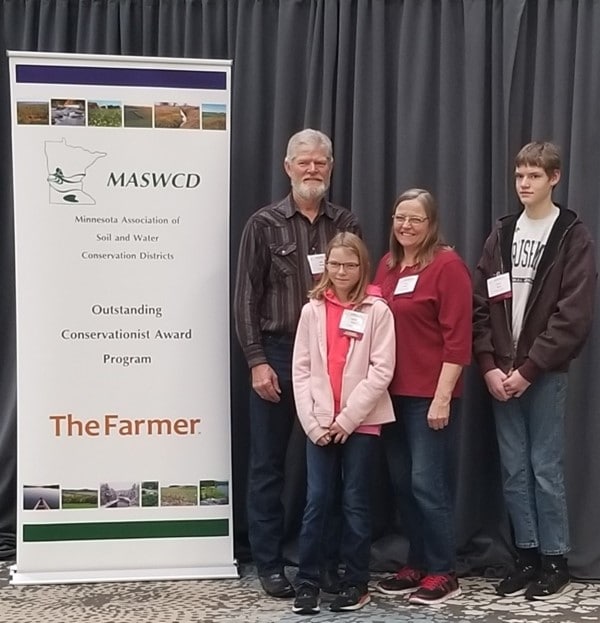
One of the true joys of getting to work with so many farmers and ranchers as they move down the regenerative path is watching as they learn how to work in synchrony with nature. It’s especially gratifying when they send along letters that describe their regenerative experiences, like the one I recently received from Daniel Flanagan:
Hi, my name is Daniel.
When I was a kid, we had small swimming pool in the backyard one summer. It sat there unused, filled with water. We had created a void in nature. Nature of course filled that void.... with mosquitoes and algae. Then one day my brothers and I caught some crawfish, one of which was carrying eggs. So, we took that crawfish home and tossed it in the pool. We took a couple of goldfish and threw them in as well. We found some pollywogs and tossed them in too.
It was fascinating to watch how the little ecosystem evolved. The fish ate all the mosquitoes, the crawfish ate the waste, moss and anything that died, the pollywogs did their thing as well. It all came to an end we added a turtle as the turtle ate absolutely everything.
Every hunter knows it would be ludicrous to burn down a forest and stock the land with White Tail deer. Every fisherman knows it would be crazy to pour chlorine into a lake to kill everything so you can stock the sterile pond of water with trophy bass.
Everybody knows what the food chain is. Everybody has an idea how a lifecycle roughly works.
Yet when we farm, we cut everything to the ground, destroy everything in the soil all so we can plant a single crop. Somehow, we completely forget everything we know about the natural world as soon as we put a plant in the ground.
I did the same thing myself. I moved to a little piece of property, cut down a section of forest, ripped out every plant, covered the ground with a 6” layer of wood chips and planted a tiny little orchard. I then started down the swirling toilet of doom by spraying chemicals.
I sprayed trees for aphids. While the spray killed the aphids, it also killed everything else on the trees—almost everything that is. What it didn't kill was spider mites. The spider mites, of course, were completely stoked as the spray that killed aphids also killed anything that ate spider mites. On and on the cycle went. I was growing trees in a relative biological desert underground and a toxic wasteland above ground.
Then last year I saw one of your videos and it clicked. All those lessons I learned in school, in nature and in that little pool in the backyard. Nothing in nature functions in a vacuum. I had forgotten all those lessons, abandoned them for conventional wisdom.
So last year I quit spraying my trees and I planted a cover crop in my tiny little orchard. I sat back, I started watching and learning. My orchard turned into an unruly jungle of plants, my wife saw the jungle, watched me standing in it staring at leaves and "weeds." She looked at me like I was crazy when I told her I was trying to learn about the bugs and plants by observing them.
Last year I learned about aphids and lady bugs. The aphids showed up like they always do. But this year I didn't spray them. I just watched. After a couple of weeks, the lady bugs showed up. Which was nice, but lady bugs don't do @#$ in terms of putting a dent in the aphid population. But then I started finding the eggs that the lady bugs laid. The eggs hatched and the ladybug larva went to work. Those larvae just destroyed the aphid population. They swept through every branch inch by inch like crazed killing machines. By the time I started finding the eggs from lacewing flies, the aphid population had been wiped out so I don't know what the lacewings ate when they hatched.
I am excited to see what my little patch of ground has to teach me this year. Will the flowers I sowed attract more helpful insects? Will the healthier soil make my trees more disease resistant? Or will some plague wipe them out? What will the influx of bugs do? I don't know. What's exciting is that I get to observe and learn.
Great job of observing and understanding Daniel, welcome to the world of regenerative agriculture!

I then received this email from our good friend and longtime regenerative practitioner John Meyer who ranches in southeastern Minnesota.
When one observes, you can’t help but begin to recognize and understand that the fully functioning soil as created by our loving God was in essence intentionally designed to be a true “perpetual motion machine.” As the organisms (people, animals, macro-biology) that are dependent upon the functioning soil for their life and livelihood gradually increase, so too does the biological activity of the microorganisms of the soil, and the incorporation of carbon of all forms, AS LONG AS THEY REMAIN IN SYMBIOTIC BALANCE WITH EACH OTHER.
What we have done in “unconventional agriculture” (and even societally) is to “force” the system artificially, by introducing concepts that artificially destroy that biological symbiotic balance, instead of incrementally working together to enhance it, thereby functioning in harmony with it. We initially learned (but didn’t make the scientific connection) that IF we increase the bacterial decomposition and release of stored carbon from the soil through heavy tillage, MORE nutrients become available to the growing plants… generating “more yield.” We corresponded that “higher yield” with being a “good farmer” so the more we tilled, for example, the “better farmer we viewed ourselves as.” The same with chemical fertilizers, and all the other “enhancements” that have been developed. We didn’t even register that we were working against the very thing that was designed into the created natural system to sustain us!
As is ALWAYS the case in natural systems, changes/disturbances that come incrementally allow the biological system to adjust and compensate. Catastrophic changes and disturbances to the system will inevitably bring catastrophic results, even if those catastrophic results aren’t’ immediately apparent to the unobserving eye (i.e. Gradually over the course of 100-150 years for example, but in the scope of created time, catastrophic loss of soil organic carbon levels, and “topsoil,” etc.). We can’t simply dump excessive amounts of one element or nutrient into the system without upsetting the proper natural self-regulating, self-organizing, self-healing balance, thereby causing a negative consequence: “For every action…there is an equal and opposite reaction.” (Isaac Newton’s Second Law of Motion).
As long as the changes we make are small and play out gradually over an extended period of time, the “system WILL adjust automatically.” Drop a bomb on any part of it though, and it doesn’t have enough time or capability to adjust just as quickly. The good news is, if we leave it alone, and get out of the way, this marvelous creation WILL once again rebuild itself!
I like to quote the nursery rhyme, “Leave them alone, and they’ll come home, wagging their tails behind them.” I know, too, it ISN’T necessary to understand every minute detail of the science. It’s all about those essential, inescapable, underlying basic principles that apply universally.
Well said John, well said.
These are two examples from our regenerative colleagues that beautifully describe the elegant symbiosis of nature—and how it is possible, by implementing regenerative principles, to enable nature to heal our soil, our ecosystems, our food and ourselves.
The most important step in regenerative agriculture is regenerative thinking. Just think of what changes would be made if we would just learn to work with the creation, instead of against it.
